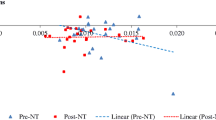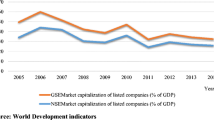Abstract
This paper examines the trading and non-trading returns to diagnose the impact of market microstructure changes on market quality. The daily data of ten agricultural commodities traded on the National Commodity and Derivative Exchange (NCDEX) were used for the study. The data has been divided into three categories: year-wise, pre- and post-reform, pre-ban, and post-ban period. The study employs variance ratio analysis, and the results suggest high daytime and opening variances. A first-order autocorrelation detects the return predictability in the data series. A Value at Risk (VaR) and Expected Shortfall (ES) methods were employed to get more detail about the downside risk of the series. It suggested that daytime return has more risk compared to overnight return. Overall, this study suggests that market microstructure effects are visible in the Indian agricultural commodity market and hardly observe any improvement in the market quality. Since we reveal the impact of policy changes on market quality, the results will be useful for policymakers.
Similar content being viewed by others
Data availability
Data can be downloaded from the NCDEX website.
References
Akbas, F., Boehmer, E., Jiang, C., & Koch, P. D. (2022). Overnight returns, daytime reversals, and future stock returns. Journal of Financial Economics, 145(3), 850–875.
Alexander, C., & Sarabia, J. M. (2011). Value-at-Risk Model. Risk. https://doi.org/10.2139/ssrn.1758548
Amihud, Y., & Mendelson, H. (1987). Trading Mechanisms and Stock Returns : An Empirical Investigation. Journal of Finance, 42(3), 533–553.
Anderson, R.M., Shik, K., Buhm, S., & Park, J. (2012). Sources of stock return autocorrelation. 1–63.
Artzner, P., Delbaen, F., Eber, J. M., & Heath, D. (1999). Coherent measures of risk. Mathematical Finance, 9(3), 203–228.
Avramov, D., Chordia, T., & Goyal, A. (2006). Liquidity and autocorrelations in individual stock returns. Journal of Finance, 61(5), 2365–2394. https://doi.org/10.1111/j.1540-6261.2006.01060.x
Bessembinder, H., & Hertzel, M. G. (1993). Return Autocorrelations around Nontrading Days. The Review of Financial Studies, 6(1), 155–189.
Bhaumik, S. K., Chakrabarty, M., Kutan, A. M., et al. (2021). How Effective Are Stock Market Reforms in Emerging Market Economies? Evidence from a Panel VAR Model of the Indian Stock Market. Journal of Quantitative Economics, 19, 795–818. https://doi.org/10.1007/s40953-021-00253-z
Bhuyan, B., Patra, S., & Bhuian, R. K. (2020). Market adaptability and evolving predictability of stock returns: An evidence from India. Asia-Pacific Financial Markets, 27, 605–619.
Bollerslev, T. (1986). Generalized autoregressive conditional heteroskedasticity. Journal of Econometrics, 31, 307–327. https://doi.org/10.1109/TNN.2007.902962
Boudoukha, J., Feldmanb, R., Koganc, S., & Richardsond, M. (2019). Information, trading, and volatility : Evidence from firm-specific news. The Review of Financial Studies, 32(3), 992–1033. https://doi.org/10.1093/rfs/hhy083/5061375
Branch, B. S., & Ma, A. (2012). Overnight return the invisible hand behind the intraday return a retrospective. Journal of Applied Finance. https://doi.org/10.2139/ssrn.3259614
Campbell, J. Y., Grossman, S. J., & Wang, J. (1993). Trading volume and serial correlation in stock returns. The Quarterly Journal of Economics, 108(4), 905–939.
Cecchetti, S. G., & Lam, P. S. (1994). Variance-ratio tests: Small-sample properties with an application to international output data. Journal of Business and Economic Statistics, 12(2), 177–186. https://doi.org/10.1080/07350015.1994.10510006
Cerqueria, A. (2006). Autocorrelation in Daily Stock Returns. 4th International Conference of the PFN—Portuguese Finance Network. Available at http://www.fep.up.pt/conferencias/pfn2006/Conference Papers/439.
Chan, K. (1993). Imperfect information and cross-autocorrelation among stock prices. Journal of Finance, 48(4), 1211–1230.
Chordia, T., Roll, R., & Subrahmanyam, A. (2008). Liquidity and market efficiency. Journal of Financial Economics, 87(2), 249–268.
Fama, E. F. (1965a). Random walks in stock market prices. Financial Analysts Journal, 21, 55–59.
Fama, E. F. (1970). Session topic: Stock market price behavior session: A review of theory and empirical work. Journal of Finance, 25(2), 383–417.
Fama, E. F. (1991). Efficient capital markets: reply. Journal of Finance, 46(5), 1575–1617.
Fama, F. E. (1965b). The behavior of stock-market prices. The Journal of Business, 38(1), 34–105.
French, K. R., & Roll, R. (1986). Stock return variances. Journal of Financial Economics, 17(1), 5–26.
Frey, R., & McNeil, A. J. (2002). VaR and expected shortfall in portfolios of dependent credit risks: Conceptual and practical insights. Journal of Banking and Finance, 26(7), 1317–1334.
Gao, R., Zhang, X., Zhang, H., Zhao, Q., & Wang, Y. (2022). Forecasting the overnight return direction of stock market index combining global market indices: A multiple-branch deep learning approach. Expert Systems with Applications, 194(1), 1–18.
Ham, H., Ryu, D., & Webb, R. I. (2022). The effects of overnight events on daytime trading sessions. International Review of Financial Analysis, 83, 102228.
Inani, S. K. (2018). Price discovery and efficiency of Indian agricultural commodity futures market: An empirical investigation. Journal of Quantitative Economics, 16(1), 129–154.
Jayawardena, N. I., Todorova, N., Li, B., & Su, J. J. (2016). Forecasting stock volatility using after-hour information: Evidence from the Australian stock exchange. Economic Modelling, 52, 592–608.
Jian, Z., Li, X., & Zhu, Z. (2020). Sequential forecasting of downside extreme risk during overnight and Daytime: Evidence from the Chinese Stock Market. Pacific Basin Finance Journal, 64(19), 101454. https://doi.org/10.1016/j.pacfin.2020.101454
Jiang, Y., Kellard, N., & Liu, X. (2020). Night trading and market quality: Evidence from Chinese and US precious metal futures markets. Journal of Futures Markets, 40(10), 1486–1507.
Krishna, K. L., & Meenakshi, J. V. (2022). Agricultural productivity growth and structural transformation in Rural India: Some recent evidence. Journal of Quantitative. Economics, 20(1), 277–302.
Kumar, D. (2020). Value-at-risk in the presence of structural breaks using unbiased extreme value volatility estimator. Journal of Quantitative Economics, 18, 587–610.
Kumar, R. (2021). Predicting wheat futures prices in India. Asia-Pacific Financial Markets, 28(1), 121–140.
Kupiec, P. H. (1995). Techniques for verifying the accuracy of risk measurement models. The Journal of Derivatives, 3(2), 73–84.
Liu, Q., Guo, H., & Wei, X. (2015). Negative overnight returns: China’s security markets. Procedia Computer Science, 55(12), 980–989.
Liu, Q., & Tse, Y. (2017). Overnight returns of stock indexes: Evidence from ETFs and futures. International Review of Economics and Finance, 48(11), 440–451.
Lockwood, L. J., & Linn, S. C. (1990). An examination of stock market return volatility during overnight and intraday periods, 1964–1989. Journal of Finance, 45(2), 591–601.
Lou, D., Polk, C., & Skouras, S. (2019). A tug of war: Overnight versus intraday expected returns. Journal of Financial Economics, 134(1), 192–213.
Madhavan, A. (2000). Market microstructure: A survey. Journal of Financial Markets. https://doi.org/10.1016/S1386-4181(00)00007-0
Masulis, R. W., & Ng, V. K. (1995). Overnight and daytime stock return-Dynamics on the London stock exchange: The impacts of “Big Bank” and the 1987 stock—market crash. Journal of Business & Economic Statistics, 13(4), 365–378.
Meng, X., & Taylor, J. W. (2020). Estimating value-at-risk and expected shortfall using the intraday low and range data. European Journal of Operational Research, 280(1), 191–202.
Mighri, Z., & Jaziri, R. (2022). Long-memory, asymmetry and fat-tailed GARCH models in value-at-risk estimation: Empirical evidence from the global real estate markets. Journal of Quantitative Economics, 21, 41–97.
Oldfield, G. S., & Rogalski, R. J. (1980). A theory of common stock returns over trading and non-trading periods. Journal of Finance, 35(3), 729–736.
Oskay, B., Linssen, T., van Vliet, T., Bouman, B., & Pasma, N. (2017). Advancing financial risk estimates by incorporating GARCH into value at risk. Available at SSRN 3137587.
Patton, A. J., Ziegel, J. F., & Chen, R. (2019). Dynamic semiparametric models for expected shortfall (and Value-at-Risk). Journal of Econometrics, 211(2), 388–413.
Puffer, M. K. (1991). Private information and weekend volatility in the Tokyo and New York stock markets. Journal of Banking and Finance, 15(2), 407–423. https://doi.org/10.1016/0378-4266(91)90075-W
Sentana, E., & Wadhwani, S. (1992). Feedback traders and stock return autocorrelations : Evidence from a century of daily data. The Economic Journal, 102(411), 415–425.
Steeley, P. S. (2005). Explaining volatility and serial correlation in opening and closing returns a study of the FT-30 components. Global Finance Journal, 16(1), 1–15.
Stoll, H. R., & Whaley, R. E. (1990). Stock market structure and volatility. The Review of Financial Studies, 3(1), 37–71.
Tsiakas, I. (2008). Overnight information and stochastic volatility: A study of European and US stock exchanges. Journal of Banking and Finance, 32(2), 251–268.
Van Ness, B., Van Ness, R., & Yildiz, S. (2021). Private information in trades, R2, and large stock price movements. Journal of Banking and Finance, 131, 1–57.
Zhu, X., Zhang, H., & Zhong, M. (2017). Volatility forecasting using high-frequency data: The role of after-hours information and leverage effects. Resources Policy, 54(2), 58–70.
Funding
The authors did not receive support from any organization for the submitted work.
Author information
Authors and Affiliations
Corresponding authors
Ethics declarations
Conflict of interest
The authors have no relevant financial or non-financial interests to disclose.
Additional information
Publisher's Note
Springer Nature remains neutral with regard to jurisdictional claims in published maps and institutional affiliations.
Appendix
Appendix
1.1 Year-wise Backtest Results for All Commodities
See Tables 20, 21, 22, 23, 24, 25, 26, 27, 28, 29.
1.2 Backtest Results for Commodities in the Pre and Post-reform Periods
1.3 Back test Results for Commodities in the Pre-ban and Post-ban Periods
Rights and permissions
Springer Nature or its licensor (e.g. a society or other partner) holds exclusive rights to this article under a publishing agreement with the author(s) or other rightsholder(s); author self-archiving of the accepted manuscript version of this article is solely governed by the terms of such publishing agreement and applicable law.
About this article
Cite this article
Pullaykkodi, S., Acharya, R.H. The Effects of Overnight Events on Daytime Return: A Market Microstructure Analysis of Market Quality. Asia-Pac Financ Markets (2023). https://doi.org/10.1007/s10690-023-09424-9
Accepted:
Published:
DOI: https://doi.org/10.1007/s10690-023-09424-9
Keywords
- Market microstructure
- Market quality
- Trading and non-trading returns
- Value at risk and Expected Shortfall
- Autocorrelation
- Private information




